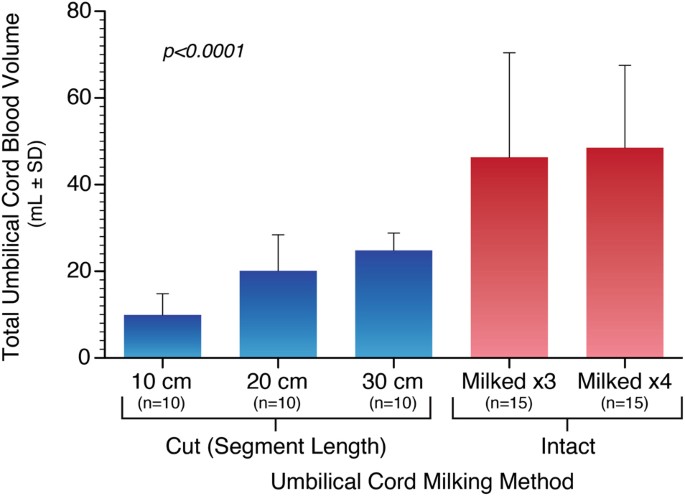
- Select a language for the TTS:
- UK English Female
- UK English Male
- US English Female
- US English Male
- Australian Female
- Australian Male
- Language selected: (auto detect) - EN
Play all audios:
ABSTRACT OBJECTIVE The objective of this study is to determine placental transfusion blood volumes with intact and cut umbilical cord milking in term newborns. STUDY DESIGN Sixty women at
≥37 weeks’ gestation were enrolled. Following delivery, the umbilical cord was immediately clamped and cut to separate the newborn. Either intact umbilical cord milking (I-UCM) of the
placental–umbilical cord unit or cut umbilical cord milking (C-UCM) of the cut umbilical cord segment was performed. For I-UCM, the cord underwent milking three or four times while being
attached to placental circulation. For C-UCM, a 10, 20, or 30 cm cord segment was cut separately and milked four times. Blood volumes were compared between I-UCM and C-UCM methods. RESULTS
Mean blood volume with I-UCM (×4) was increased compared to the 30 cm C-UCM technique (48.5 ± 19.0 vs. 24.8 ± 4.0 mL, _P_ < 0.001). For C-UCM, blood volume increased proportionally to
cord length and, by the second milking, 98.1 ± 4.5% of blood volume was delivered. CONCLUSION I-UCM provides a greater blood volume than C-UCM. With C-UCM, milking the cord more than twice
offers no additional advantage. Access through your institution Buy or subscribe This is a preview of subscription content, access via your institution ACCESS OPTIONS Access through your
institution Subscribe to this journal Receive 12 print issues and online access $259.00 per year only $21.58 per issue Learn more Buy this article * Purchase on SpringerLink * Instant access
to full article PDF Buy now Prices may be subject to local taxes which are calculated during checkout ADDITIONAL ACCESS OPTIONS: * Log in * Learn about institutional subscriptions * Read
our FAQs * Contact customer support SIMILAR CONTENT BEING VIEWED BY OTHERS UMBILICAL CORD MILKING VERSUS DELAYED CORD CLAMPING IN TERM INFANTS: A SYSTEMATIC REVIEW AND META-ANALYSIS Article
24 September 2020 PLACENTAL TRANSFUSION DURING NEONATAL RESUSCITATION IN AN ASPHYXIATED PRETERM MODEL Article 30 April 2022 NEONATAL FACTORS IMPACTING UMBILICAL CORD BLOOD UNIT
CHARACTERISTICS Article Open access 14 May 2025 REFERENCES * McDonald SJ, Middleton P, Dowswell T, Morris PS. Effect of timing of umbilical cord clamping of term infants on maternal and
neonatal outcomes. Cochrane Database Syst Rev. 2013;7:CD004074. Google Scholar * Raju TN. Timing of umbilical cord clamping after birth for optimizing placental transfusion. Curr Opin
Pediatr. 2013;25:180–87. Article PubMed Google Scholar * Rabe H, Diaz-Rossello JL, Duley L, Dowswell T. Effect of timing of umbilical cord clamping and other strategies to influence
placental transfusion at preterm birth on maternal and infant outcomes. Cochrane Database Syst Rev. 2012;8:CD003248. Google Scholar * WHO Guidelines Approved by the Guidelines Review
Committee. Guideline: delayed umbilical cord clamping for improved maternal and infant health and nutrition outcomes. Geneva: World Health Organization; 2014. Google Scholar * Weiner G.
Textbook of neonatal resuscitation. 7th ed. Elk Grove Village, Il: American Academy of Pediatrics; 2016. Google Scholar * Wyllie J, Perlman JM, Kattwinkel J, Wyckoff MH, Aziz K, Guinsburg
R, et al. Part 7: neonatal resuscitation: 2015 international consensus on cardiopulmonary resuscitation and emergency cardiovascular care science with treatment recommendations.
Resuscitation. 2015;95:e169–201. Article PubMed Google Scholar * Committee Opinion No. 684. Delayed umbilical cord clamping after birth. Obstet Gynecol. 2017;129:e5–10. Article Google
Scholar * Al-Wassia H, Shah PS. Efficacy and safety of umbilical cord milking at birth: a systematic review and meta-analysis. JAMA Pediatr. 2015;169:18–25. Article PubMed Google Scholar
* Dang D, Zhang C, Shi S, Mu X, Lv X, Wu H. Umbilical cord milking reduces need for red cell transfusions and improves neonatal adaptation in preterm infants: meta-analysis. J Obstet
Gynaecol Res. 2015;41:890–95. Article PubMed Google Scholar * Patel S, Clark EA, Rodriguez CE, Metz TD, Abbaszadeh M, Yoder BA. Effect of umbilical cord milking on morbidity and survival
in extremely low gestational age neonates. Am J Obstetr Gynecol. 2014;211:519 e511–17. Article Google Scholar * Katheria AC, Truong G, Cousins L, Oshiro B, Finer NN. Umbilical cord milking
versus delayed cord clamping in preterm infants. Pediatrics. 2015;136:61–9. Article PubMed PubMed Central Google Scholar * Katheria A, Blank D, Rich W, Finer N. Umbilical cord milking
improves transition in premature infants at birth. PLoS ONE. 2014;9:e94085. Article PubMed PubMed Central Google Scholar * Rabe H, Sawyer A, Amess P, Ayers S. Brighton perinatal study G.
neurodevelopmental outcomes at 2 and 3.5 years for very preterm babies enrolled in a randomized trial of milking the umbilical cord versus delayed cord clamping. Neonatology.
2016;109:113–19. Article PubMed Google Scholar * March MI, Hacker MR, Parson AW, Modest AM, de Veciana M. The effects of umbilical cord milking in extremely preterm infants: a randomized
controlled trial. J Perinatol. 2013;33:763–67. Article CAS PubMed PubMed Central Google Scholar * Sweet DG, Carnielli V, Greisen G, Hallman M, Ozek E, Plavka R, et al. European
consensus guidelines on the management of respiratory distress syndrome - 2016 update. Neonatology. 2017;111:107–25. Article CAS PubMed Google Scholar * Yadav AK, Upadhyay A, Gothwal S,
Dubey K, Mandal U, Yadav CP. Comparison of three types of intervention to enhance placental redistribution in term newborns: randomized control trial. J Perinatol. 2015;35:720–24. Article
CAS PubMed Google Scholar * Bora R, Akhtar SS, Venkatasubramaniam A, Wolfson J, Rao R. Effect of 40-cm segment umbilical cord milking on hemoglobin and serum ferritin at 6 months of age
in full-term infants of anemic and non-anemic mothers. J Perinatol. 2015;35:832–36. Article CAS PubMed Google Scholar * Hosono S, Mugishima H, Takahashi S, Takahashi S, Masaoka N,
Yamamoto T, et al. One-time umbilical cord milking after cord cutting has same effectiveness as multiple-time umbilical cord milking in infants born at <29 weeks of gestation: a
retrospective study. J Perinatol. 2015;35:590–94. Article CAS PubMed Google Scholar * Kumar B, Upadhyay A, Gothwal S, Jaiswal V, Joshi P, Dubey K. Umbilical cord milking and
hematological parameters in moderate to late preterm neonates: a randomized controlled trial. Indian Pediatr. 2015;52:753–57. Article PubMed Google Scholar * Jaiswal P, Upadhyay A,
Gothwal S, Chaudhary H, Tandon A. Comparison of umbilical cord milking and delayed cord clamping on cerebral blood flow in term neonates. Indian J Pediatr. 2015;82:890–95. Article PubMed
Google Scholar * Rabe H, Jewison A, Alvarez RF, Crook D, Stilton D, Bradley R, et al. Milking compared with delayed cord clamping to increase placental transfusion in preterm neonates: a
randomized controlled trial. Obstet Gynecol. 2011;117(2 Pt 1):205–11. Article PubMed Google Scholar * Katheria AC, Lakshminrusimha S, Rabe H, McAdams R, Mercer JS. Placental transfusion:
a review. J Perinatol. 2017;37:105–11. Article CAS PubMed Google Scholar * Fanaroff and Martin's Neonatal-Perinatal Medicine. Diseases of the fetus and infant. 10th ed.
Philadelphia, PA: Saunders; 2015. Google Scholar * Hosono S, Hine K, Nagano N, Taguchi Y, Yoshikawa K, Okada T, et al. Residual blood volume in the umbilical cord of extremely premature
infants. Pediatr Int. 2015;57:68–71. Article PubMed Google Scholar * Hooper SB, Binder-Heschl C, Polglase GR, Gill AW, Kluckow M, Wallace EM, et al. The timing of umbilical cord clamping
at birth: physiological considerations. Matern Health Neonatol Perinatol. 2016;2:4. Article PubMed PubMed Central Google Scholar Download references ACKNOWLEDGEMENTS We gratefully
acknowledge the technical assistance of Jan Hamanishi in preparing the figures and the statistical advice provided by Jens Eickhoff. There were no sources of funding for this project. Data
from this study were presented as a poster at the ACOG Annual Clinical and Scientific Meeting in San Diego, CA, in May 2017 and the Pediatric Academic Society Meeting in San Francisco, CA,
in May 2017. AUTHOR INFORMATION AUTHORS AND AFFILIATIONS * Department of Pediatrics, University of Washington, Seattle, WA, USA Ryan M. McAdams * Department of Obstetrics and Gynecology,
University of Washington, Seattle, WA, USA Emily Fay & Shani Delaney * Department of Pediatrics, University of Wisconsin School of Medicine and Public Health, Madison, WI, USA Ryan M.
McAdams Authors * Ryan M. McAdams View author publications You can also search for this author inPubMed Google Scholar * Emily Fay View author publications You can also search for this
author inPubMed Google Scholar * Shani Delaney View author publications You can also search for this author inPubMed Google Scholar CORRESPONDING AUTHOR Correspondence to Ryan M. McAdams.
ETHICS DECLARATIONS COMPETING INTEREST The authors declare that they have no competing financial interest. RIGHTS AND PERMISSIONS Reprints and permissions ABOUT THIS ARTICLE CITE THIS
ARTICLE McAdams, R.M., Fay, E. & Delaney, S. Whole blood volumes associated with milking intact and cut umbilical cords in term newborns. _J Perinatol_ 38, 245–250 (2018).
https://doi.org/10.1038/s41372-017-0002-x Download citation * Received: 14 June 2017 * Revised: 08 September 2017 * Accepted: 04 October 2017 * Published: 12 December 2017 * Issue Date:
March 2018 * DOI: https://doi.org/10.1038/s41372-017-0002-x SHARE THIS ARTICLE Anyone you share the following link with will be able to read this content: Get shareable link Sorry, a
shareable link is not currently available for this article. Copy to clipboard Provided by the Springer Nature SharedIt content-sharing initiative




